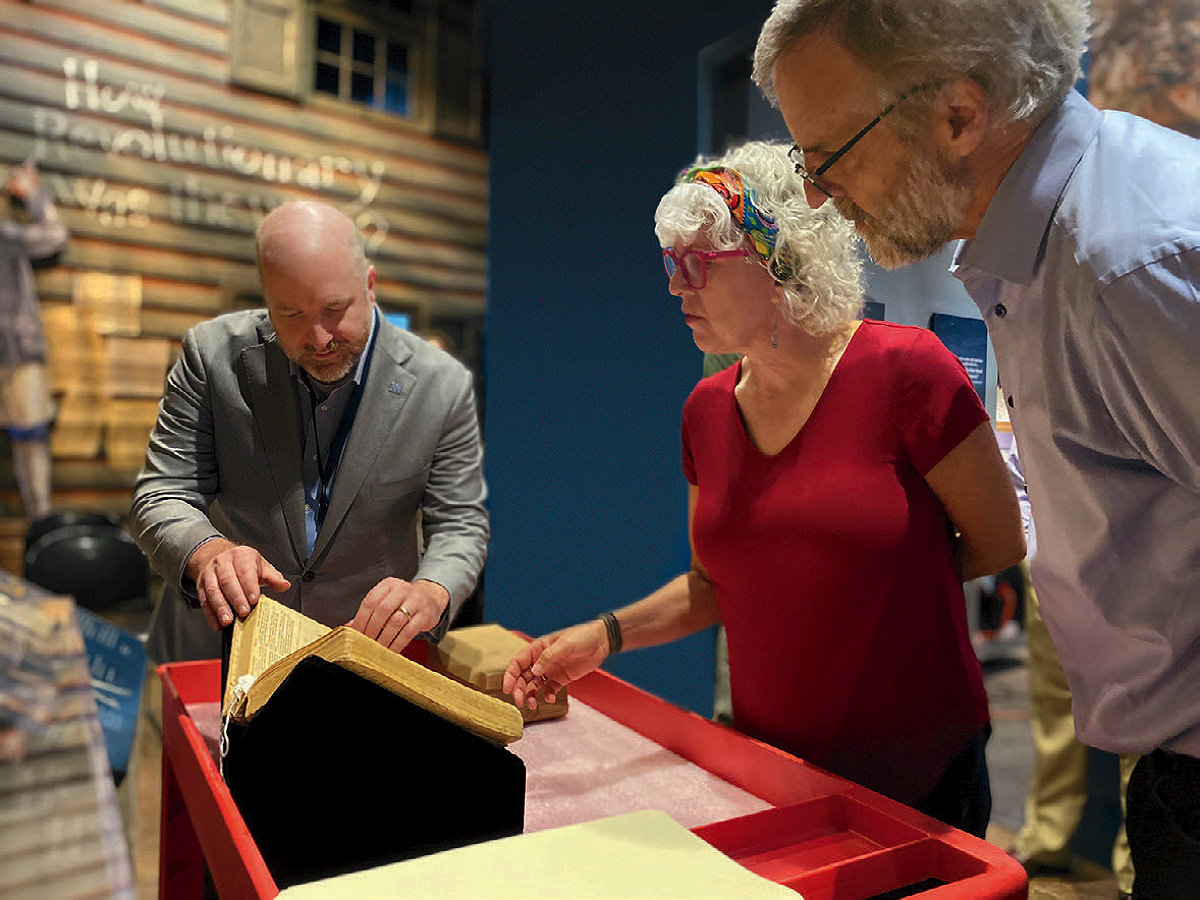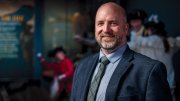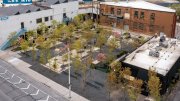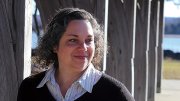At Philadelphia’s Museum of the American Revolution, displays marking pivotal events loom large. The first shots heard in Lexington and Concord. George Washington and troops crossing the Delaware River. A dramatic unveiling of the general’s wartime tent headquarters. Yet chief historian and curator Philip C. Mead, Ph.D. ’12, is especially proud of a less splashy exhibit: a simple tableau featuring women voting in 1801—more than a century before the passage of the Nineteenth Amendment.
The scene commemorates what scholars call “the New Jersey exception.” From 1776 to 1807, property-owning women in that state, including free people of color, could legally vote in elections. Such early enfranchisement was part of a growing national and international movement to increase citizens’ rights, inspired by revolutionary ideology. The exhibit shows, he says, that “Americans were in some ways more progressive than we might have imagined; that there was more experimentation and exploration.” Even the fact that women’s right to vote was rescinded in 1807 reveals the historic backdrop of contending “backlashes and opinions,” he adds. “So, all of these kinds of debates are longstanding and rooted in our revolutionary past.”
Mead began studying the American Revolution in grammar school and has never stopped, fascinated by the central question: “What do people do when they’ve decided to change the basis of their system of government?” In 2010, while grappling with these ideas and poring over soldiers’ diaries for his dissertation, Mead met R. Scott Stephenson (now president and CEO of the museum) at an antiques show and joined the effort to develop the nascent museum as a project historian, becoming a staff historian and curator in 2014. The new $150-million museum, built in Philadelphia’s historic district, opened on April 19, 2017, the 242nd anniversary of the “shot heard round the world” that ignited the Revolutionary War. It’s a private, nonpartisan, nonprofit organization, initially funded through a capital campaign with leading gifts from founding chairman H.F. “Gerry” Lenfest (a prominent lawyer, media executive, and philanthropist), the Commonwealth’s Redevelopment Assistance Capital Program, and the Oneida Indian Nation. It is now funded primarily through earned revenue, memberships, and donations.

Mead is an academic historian, given to weaving primary sources into pertinent narratives, but tracking down and handling the tangible proof of the past thrills him—and explains why he also revels in the role of curator.
To develop the New Jersey exception tableau, “When Women Lost the Vote: A Revolutionary Story, 1776-1807,” Mead and curatorial fellow Marcela Micucci spent months scouring New Jersey archives for historic “poll lists.” In the late 1700s, he says, elections were held in homes or businesses; people gathered, and if no one objected when their names were called (on grounds like lack of local residency or property ownership), their names were added to the list and they cast their votes. Any surplus ballots were pulled as an early attempt to protect against fraud.
The day their research yielded proof of women’s enfranchisement, he remembers, “[Micucci] came into my office waving a copy of the list over her head like it was the Ten Commandments coming down from the Mount.” They sped to the New Jersey State Archives in Trenton to see the handwritten Somerset County list, on which 46 of the 343 names were women’s. For Mead, the artifact catalyzed a reimagining of the election. “It’s a compelling object because it sat in the midst of the actual voting in the room—in this case, it was an inn,” he says. “People were coming in and voting and there are others there sitting and smoking and talking about the campaigns. Most of these people would have known each other, and it was friendly enough but with a lot of political talk and some tensions.” He and Micucci then traced the names to gravestones in nearby cemeteries. “Standing there, going from artifact to the real person,” he recalls,” makes it all even more human. It makes it personal.”
The past has always seemed vivid to Mead. Growing up in Connecticut, he was to learn in grade school that his hometown, Simsbury, had been torched during King Philip’s War in 1676. “That this happened here—that the landscape you drive around with your parents and walk and play in was once the site of an enormously significant war and conflict of cultures is really hard, and still hard, for me to wrap my head around,” he says. “Part of why early American history has so long interested me is because of the absence of visual resources. That makes it a greater challenge for research, study, and the imagination.”
His own paternal family history—the Meads arrived in America in 1635—was another source of curiosity. By 1672, the Meads had settled in Greenwich, Connecticut, where they appeared on a record that year of the town’s proprietors. Generations lived in two Cos Cob homes for more than 250 years. In the 1950s, however, Mead’s paternal grandmother cleaned “a little too aggressively” and threw out an attic full of family artifacts. Mead says his father remembers seeing Edison’s cylinders, the original version of sound recordings, “winged out the window and crashing on the driveway,” along with chests filled with period clothing—bonnets and military uniforms and shoes. For Mead, “it was like torture to hear these stories.”
Having settled on studying history in high school, Mead headed to Brown University specifically to study with American history scholar and Way University Professor (now emeritus) Gordon S. Wood, Ph.D. ’64, with whom he subsequently co-edited Essays by “The Free Republican,” 1784–1786. After graduation in 2000, Mead headed to Harvard Business School where he spent two years as a case writer to test whether anything else might capture his passion more than history (nothing did). Then he began his doctoral studies under 300th Anniversary University professor Laurel Thatcher Ulrich (since retired).
“It’s being in the presence of the surviving evidence of what this person created...this is the closest thing we have to meeting them.”
In casting about for a dissertation focus, Mead became intrigued by the diaries of soldiers fighting in the American Revolution. Many of the journals were viewable on microfilm, but he sought out the objects themselves and became absorbed in what the artifacts conveyed. “You begin to see the wear patterns on the paper,” he says, “and notice evidence of solutions to creating privacy: latches and strings closing the diaries, or you see the diary disguised as a wallet or a book of poetry. Some soldiers wrote in other languages to record something but not for everyone to read.” Mead was also attracted by their enduring physicality. “It’s being in the presence of the surviving evidence of what this person created of their travels and experiences; this is the closest thing we have to meeting them,” he says. “It was a powerful moment picking up on their project and adapting it to my own. You sometimes start to feel like you’re collaborating on telling their story.”
Ultimately, his dissertation, “Melancholy Landscapes: Writing Warfare in the American Revolution,” drew on 169 diaries to explore how the soldiers often “barely understood, or accepted as part of their community, large parts of the country for which they fought,” his dissertation abstract states. The soldiers were caught up in an improvisational time, fighting for survival, without knowing exactly what kind of country they’d find come war’s end.
Mead points to the emerging figure of General George Washington, who also struggled to find the right approach to leading the burgeoning nation. That’s encapsulated in Washington’s early decision to wear a blue silk shoulder sash into the field, the first symbol of an American commander. In 2011 Mead rediscovered the sash in the Peabody Museum of Archaeology and Ethnology collections and worked with conservator T. Rose Holdcraft to authenticate it. The sash served to identify him as commander in the field, when many of his soldiers did not know what he looked like. Yet it was a risky choice because it closely resembled the blue ribbons worn by marshals of France or British nobility and thereby introduced unwanted association with a tyrannical aristocracy. “In some ways, the sash represents the biggest question of the Revolution, which is: What is authority in a republic?” Mead notes. “Washington faced this issue throughout his leadership, becoming the closest thing Americans had to a monarch.”
Mead balances museum work with raising a young family, beekeeping, traveling, and stewarding a historic home. But the search for artifacts and their stories never ends. On vacation a few years ago, Mead went to a New Hampshire antiques show and came upon an eighteenth-century diary that shed new light on the historic figure Deborah Sampson, who dressed as a man to fight in the war (it is now part of the museum’s permanent collection). In 2017, in an online auction a few weeks before the museum opened, he found a seven-foot panoramic watercolor painting that Mead believes was the work of military engineer Pierre Charles L’Enfant (who also designed the basic layout for Washington, D.C.). The watercolor scenes, on six attached pieces of paper, were verified as views of the Continental Army’s 1782 encampments at Verplanck’s Point in the Hudson Valley—and the only known wartime depiction of Washington’s tent, his mobile command center. The tent was present at many crucial junctures, Mead says, including the 1781 Siege of Yorktown, and was where Washington ate, slept, and lived in the field. It has a complex provenance but was on display for years at the Valley Forge Historical Society, the predecessor organization of the Museum of the American Revolution. It is now on permanent display, part of an exhibition culminating in a rousing theatrical reveal.
Without grounding history in objects and visual cues, historic stories can become lost. “We need these paintings, for example, to look out across the landscape as it was and see what the Army encampment was like, what the people there were up against, how they lived and fought,” Mead says. “But I can identify with them, and they’re not that different from me. That, I think, is the power. We are in our own different time, but we can see some of ourselves as part of something larger, as a larger human community, across space and time. We’re not so isolated then.”







